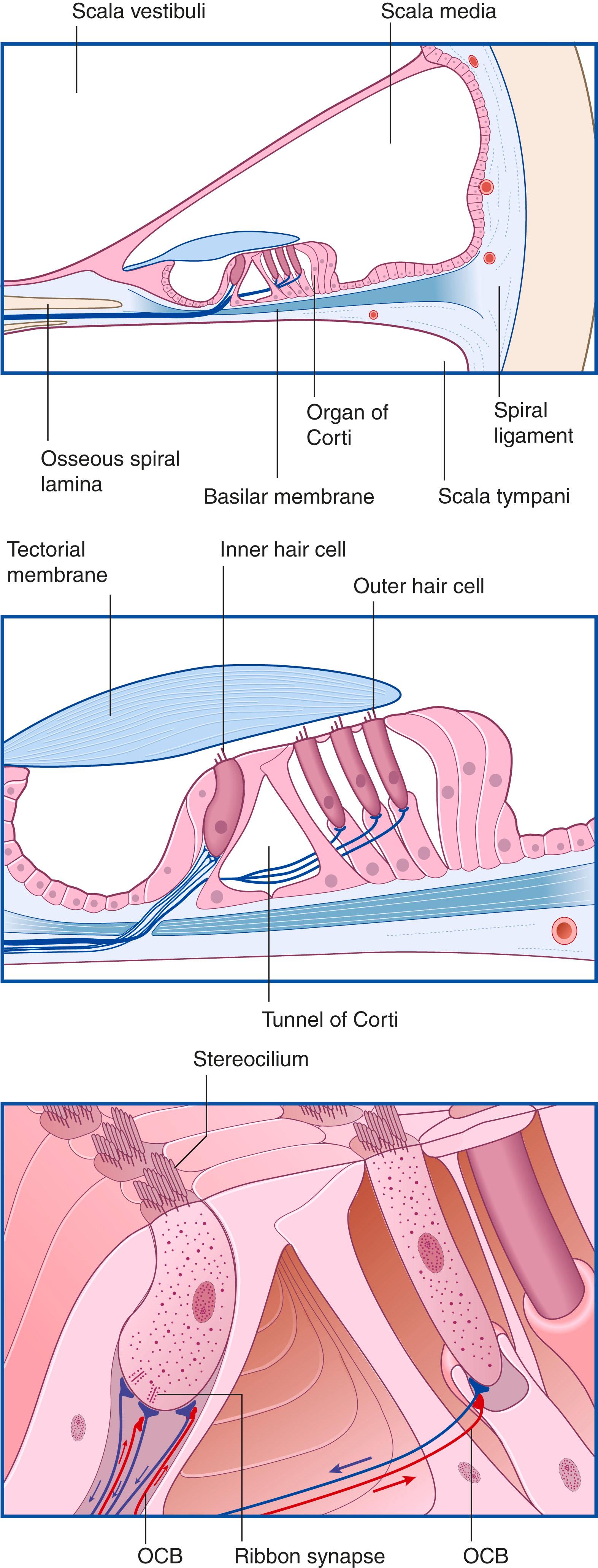Physical Address
304 North Cardinal St.
Dorchester Center, MA 02124
Describe the mechanism of how vibrations created by sound waves result in activation of the organ of Corti.
Be able to identify the scala vestibuli, scala tympani, and scala media and components of the spiral organ.
Reproduce the central auditory pathway from the spiral ganglion to the primary auditory cortex.
Describe the role of the olivocochlear bundle.
The auditory system comprises the cochlea, the cochlear nerve, and the central auditory pathway travelling from the cochlear nuclei in the brainstem to the cortex of the temporal lobe. The central auditory pathway is more elaborate (provides for more processing of the signal) than the somatosensory or visual pathways because the ‘same’ sounds are detected by both ears. To signal the location of a sound as well as perform further processing prior to transmission to the thalamus and cortex, a very complex neuronal network is in place. Numerous connections (mainly inhibitory) between the two central pathways exist to accomplish this task, as well as to magnify minute differences in intensity and timing of sounds that exist during normal, binaural hearing.
The main features of the cochlear structure are seen in Figs 20.1 and 20.2 . The cochlea is pictured as though it were upright, but in life it lies on its side, as shown earlier in Fig. 19.1 . The central bony pillar of the cochlea (the modiolus ) is in the axis of the internal acoustic meatus. Projecting from the modiolus, like the flange of a screw, is the osseous spiral lamina . The basilar membrane is attached to the tip of this lamina; it reaches across the cavity of the bony cochlea to become attached to the spiral ligament on the outer wall. The osseous spiral lamina and spiral ligament become progressively smaller as one ascends the two and one half turns of the cochlea, and the fibres of the basilar membrane become progressively longer.


The basilar membrane and its attachments divide the cochlear chamber into upper and lower compartments. These are the scala vestibuli and the scala tympani , respectively, and they are filled with perilymph. They communicate at the apex of the cochlea, through the helicotrema . A third compartment, the scala media (cochlear duct) , lies above the basilar membrane and is filled with endolymph. It is separated from the scala vestibuli by the delicate vestibular membrane (Reissner membrane) .
Sitting on the basilar membrane is the spiral organ (organ of Corti) . The principal sensory receptor epithelium consists of a single row of inner hair cells (sensory receptors), each one having up to 20 large afferent nerve endings applied to it. The hair cells rest upon supporting cells . There are also ancillary cells. The organ of Corti contains a central tunnel , filled with endolymph diffusing through the basilar membrane. On the outer side of the tunnel are several rows of outer hair cells , attended by supporting and ancillary cells ( Fig. 20.2 ).
All the hair cells are surmounted by stereocilia . Unlike the vestibular hair cells, they have no kinocilium in the adult state. The stereocilia of the outer hair cells are embedded in the overlying tectorial membrane. Those of the inner hair cells lie immediately below the membrane.
Deflection of these stereocilia activates mechanically gated channels, causing the hair cell to depolarise and activate its afferent nerve endings from the cochlea ganglion (or spiral ganglion ).
The outer hair cells are contractile, and they have substantial efferent nerve endings (see Fig. 20.2 ). It has been suggested that the oscillatory movements of outer hair cells influence the sensitivity of the inner hair cells through effects on the tectorial or basilar membrane.
Vibrations of the tympanic membrane in response to sound waves are transmitted along the ossicular chain. The footplate of the stapes fits snugly into the oval window, and vibrations of the stapes are converted to pressure waves in the scala vestibuli. The pressure waves are transmitted through the vestibular membrane to reach the basilar membrane. High-frequency pressure waves, created by high-pitched sounds, cause the short fibres of the basilar membrane in the basal turn of the cochlea to resonate and absorb their energy. Low-frequency waves produce resonance in the apical turn, where the fibres are the longest. The basilar membrane is therefore tonotopically organized in its fibre sequence. Not surprisingly, the inner hair cells have a similar tonotopic sequence. In response to local resonance, the cells depolarise and liberate excitatory transmitter substance from synaptic ribbons (see Fig. 20.2 ).
The nerve fibres supplying the hair cells are the peripheral processes of the bipolar cochlear or spiral ganglion neurons lodged in the base of the osseous spiral lamina.
The bulk of the cochlear nerve consists of myelinated central processes of some 30,000 large bipolar neurons of the cochlea (or spiral ) ganglion . Unmyelinated fibres come from small ganglion cells supplying dendrites to the outer hair cells. (Motor fibres do not travel in the cochlear nerve trunk.) The cochlear nerve traverses the subarachnoid space in company with the vestibular and facial nerves, and it enters the brainstem at the pontomedullary junction.
Become a Clinical Tree membership for Full access and enjoy Unlimited articles
If you are a member. Log in here